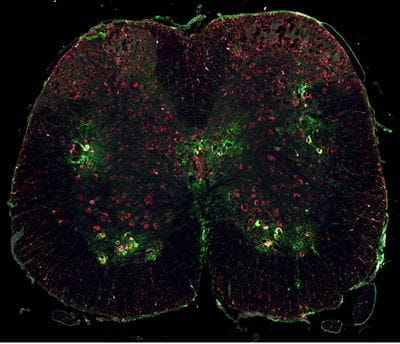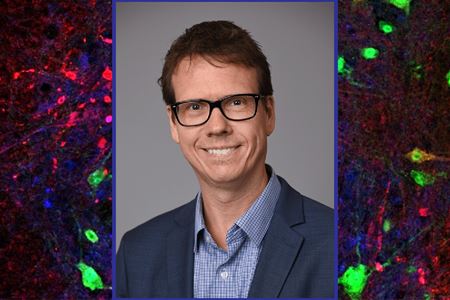Clubs abound for all types of interests — sports, books, music, cooking — but here’s one you probably haven’t heard of: the Motoneuron Club. This club at the Indiana University School of Medicine focuses on understanding motor neurons, a type of nerve cell that transmits signals from the brain and spinal cord to initiate movement.
Motoneurons play a key role in amyotrophic lateral sclerosis, more commonly known as ALS or Lou Gehrig’s disease, which afflicts about one in 10,000 people, robbing them of the ability to walk, dress, write, speak, swallow and, eventually, breathe.
“It’s the disease neurologists fear to get,” said Brian Pierchala, PhD, the Sherry Sonneborn Professor of ALS Research and an investigator with IU’s Stark Neurosciences Research Institute, who helps lead the Motoneuron Club.
Average survival time after an ALS diagnosis is just 2 to 5 years.
“Part of the reason I do this research and am passionate about it is because there’s just so little we can do for patients,” Pierchala said. “I hope to be able to increase our understanding of the disease and identify targets for therapies.”
His work became more personal after meeting Sherry and Mike Sonneborn, who sold a home in Florida following Sherry’s ALS diagnosis and put the money toward endowing an ALS research position at the IU School of Medicine, which Pierchala holds. Sherry died in 2020, four years after diagnosis.
“Meeting Sherry definitely changed the way I view my ALS research,” Pierchala said. “I really ask the question, ‘Is what we’re doing in the lab potentially therapeutic?’ Let’s just say I’m swinging at what I think are the best pitches now.”
Building the ALS team
Team science is essential when it comes to combatting a disease as complex as ALS. That’s why Kathryn Jones, PhD, professor and chair emeritus of the Department of Anatomy, Cell Biology and Physiology, cofounded the Motoneuron Club in 2012, along with Robert Pascuzzi, MD, in the Department of Neurology. The idea was to bring together IU scientists and clinicians studying ALS and other motoneuron-related conditions to advance treatments and accelerate discovery.
 “The peripheral motoneuron is one of the largest and most complex of cells in the human body,” Jones said. “It has widespread connections with all parts of the brain and spinal cord, as well as virtually all the skeletal muscles of the body. Such complexity makes it extremely challenging to pinpoint underlying causes of ALS.”
“The peripheral motoneuron is one of the largest and most complex of cells in the human body,” Jones said. “It has widespread connections with all parts of the brain and spinal cord, as well as virtually all the skeletal muscles of the body. Such complexity makes it extremely challenging to pinpoint underlying causes of ALS.”
Every two years, the club hosts its Midwest Motoneuron Research Conference, drawing regional scientists studying ALS. Connections from the motoneuron conference led to Pierchala’s recruitment from the University of Michigan in 2019.
The Pierchala Lab at IU uses human stem cell cultures and mouse models to study how motoneurons change as ALS progresses. Pierchala’s team also studies environmental factors that might increase the risk for developing ALS.
New genes have been discovered related to some cases of ALS, but 85% of cases are considered “sporadic,” meaning there’s no family link. Developing drugs to help these patients is much more difficult since a specific gene cannot be targeted. Pierchala suspects exposure to environmental toxins might work in tandem with an unknown genetic susceptibility to cause ALS.
Smoking and military service are the only two known environmental factors that most scientists agree increase ALS risk — although no one knows quite why. Other potential factors being studied include heavy metals, pesticides and PCBs.
“We need to dig deeper to see how neurons respond differently in people with ALS — how they’re getting sick from environmental toxins,” Pierchala said. “If we could prevent ALS from ever happening, by changing the environment or protecting people from things that are in the environment that we can’t get away from, that would be the best scenario.”
Speeding up therapeutic discovery
Efforts to understand the molecular mechanisms of ALS have been slow, but Pierchala sees the pace picking up with new technologies in microscopic imaging and other areas. One game changer has been the ability to easily take a blood or skin sample and “reprogram” those cells back to human stem cells. Pierchala’s lab converts these stem cells into motoneurons, allowing them to study samples from ALS patients alongside a control group.
 “It’s an unbelievable time to do neuroscience,” Pierchala said. “Things are being discovered faster than ever before.”
“It’s an unbelievable time to do neuroscience,” Pierchala said. “Things are being discovered faster than ever before.”
While many Stark researchers study Alzheimer’s and related dementias, Pierchala is among those growing IU’s neuromuscular disease research. He works closely with collaborators at the Indiana Center for Musculoskeletal Health, including Jeff Brault, PhD, who studies muscle metabolism.
“One thing that’s exciting about IU is there’s a whole breadth of knowledge here,” Pierchala said. “The ICMH has a number of investigators studying various aspects of muscle control and wasting and also bone biology — that’s been an exciting collaboration.”
Other IU researchers work directly with ALS patients through clinical trials. IU currently has 10 trials in ALS and neuromuscular diseases. Cynthia Bodkin, MD, is leading a new research study for people with ALS and their close relatives. ALL-ALS aims to study the genetics and biomarkers of the disease through blood and cerebrospinal fluid collection.
Pierchala’s work in basic and translational science is supported by the NIH and the Sonneborn endowment. He’s also exploring industry partnerships and appreciates the robust scientific community growing in Indianapolis, specifically within IU’s Stark Neurosciences Research Institute.
“It’s a great place for research, and it’s something that’s really special for Indiana and something we can look at with excitement and pride as we continue to grow and make discoveries,” Pierchala said.
